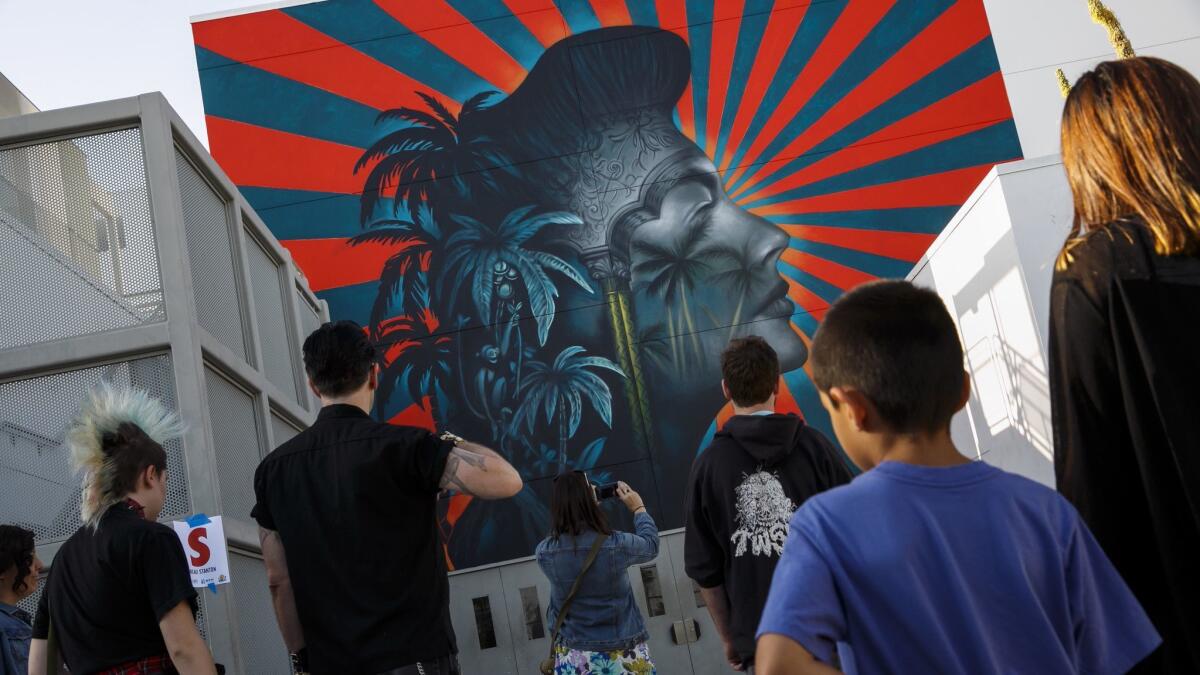An artist met with those who fought to have his mural removed. The tone was cordial, but it won’t save the art

- Share via
When an artist met his critics on Thursday afternoon, the conversation was friendly. But it didn’t change the outcome for his artwork at a school in Koreatown.
The days remain numbered for Beau Stanton’s mural of actress Ava Gardner at the Robert F. Kennedy Community Schools complex because local Korean activists say the painting’s background reminds them of the Japanese imperial battle flag, which they liken to a swastika.
After meeting with the artist and those who want his mural gone at a law firm in Koreatown, a Los Angeles Unified School District official reaffirmed plans to obliterate the piece. And the coalition of local Koreans that led the charge to remove it once again expressed satisfaction with the decision.
Stanton’s presence was the main difference between this news conference and one last week at which the decision was announced. The artist, who had donated his time to paint the mural, was respectful — posing for photos, handshakes and even an awkward hug with his Korean hosts — but he left disappointed.
“I came here to represent the intention behind the mural and to reach out and be thoughtful and to hear their side,” Stanton said in an interview afterward. “I stand by saying that censoring an artwork is not appropriate in this situation and especially not in an educational environment.”
The mural is intended as a celebration of the Cocoanut Grove, the famous Hollywood watering hole that was once located nearby. The profile of the screen icon is its dominant feature, with a monkey, palm trees and a Moorish arch superimposed on her face to evoke the club’s exotic decor.
What disturbs the Korean activists, however, are the sun rays emanating from Gardner’s face. For them, the rays are too reminiscent of a flag they associate with atrocities.
Imperial Japan ruled Korea as a colony from 1910 to 1945. Before and during World War II, Japanese forces in Korea and elsewhere oversaw brutal forced-labor camps, forced prostitution, mass killings and cruel medical experimentation on captives.
The Japanese battle flag has 32 bands, of uniform proportions, in alternating red and white around a centered red disk, representing the sun. Stanton’s mural has 42 varying bands of blue and reddish-orange, surrounding a much larger and different central image.
Such rays are one of his common motifs, which worries him.
The leader of the Korean coalition said that his group would not go out of its way to target Stanton, but that the artist might need to put an explanation or disclaimer on his other works of art.
“We don’t want to bother him again and again,” said Chan Yong “Jake” Jeong, a local attorney.
“We respect Mr. Stanton as an artist, a very great artist, and we want to respect his freedom of speech,” Jeong said. “We have no doubt about his good faith.”
Jeong suggested that his group would go after other similar artistic representations of sun rays, which are not hard to find. The state flag of Arizona, for example, much more closely resembles the Japanese flag that the critics find offensive —though it, too, has nothing to do with Japan, let alone Japanese imperialism.
“How about a swastika on the flag of Arizona?” Jeong said. “Is that objectionable?”
Jeong has spoken of the mural as a hate crime that could expose the district and artist to civil and criminal penalties, a view that some legal experts questioned.
School district officials never said that such possibilities led them to remove the mural. They simply said they thought it would be best.
School buildings belong to the community, said Eugene Hernandez, administrator of operations for the region that includes the school.
“It’s about all of us coming together,” he said.
School board members and Supt. Austin Beutner did not respond to requests for comment about the issue.
Jeong said Stanton would be his first choice to paint a new mural in the same spot, but Stanton said he would not return to that particular wall. He also said he would hesitate to work for L.A. Unified again given that it would not defend his art from complaints that might arise.
“I think that the primary grievance here is that this period of Korean history is not well known in America,” Stanton said. “One positive thing is that they’re educating all parties here, myself included, about their visceral response to the Japanese flag.
“Speaking to each other face to face is helpful,” he said. “I understand how they feel. And I also am against getting rid of this mural.”
Twitter: @howardblume
More to Read
Sign up for Essential California
The most important California stories and recommendations in your inbox every morning.
You may occasionally receive promotional content from the Los Angeles Times.














